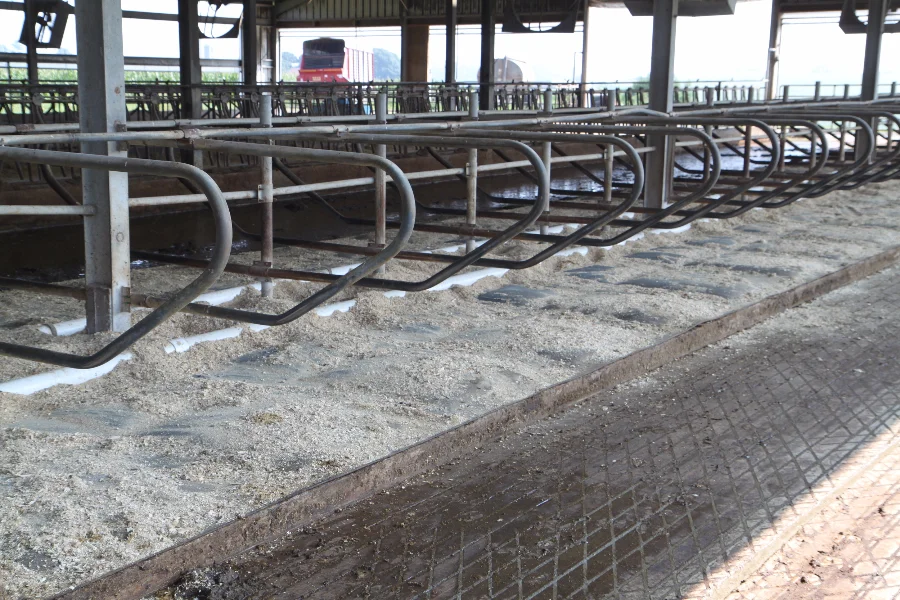TALKING ABOUT DCC WATERBEDS CAN REALLY ATTRACT ATTENTION.
PEOPLE ARE AMAZED THAT COWS AROUND THE WORLD SLEEP ON WATERBEDS.
DCC Waterbeds’ patented dual-chamber bed is the only bedding surface that provides consistent, stable cushion for cow descent each and every time she lies down. The physical properties of water lend comfort, suspending the cow’s pressure points, gently moving with her skin, and creating a convex surface that stays clean and dry.
FREQUENTLY ASKED QUESTIONS
1) How does the DCC Waterbed protect the cow’s pressure points?
The dual-chamber design of a DCC Waterbed ensures that the front pillow is firm and full of water, so when the cow drops to her knees, they are supported in the descent. As she lies down, her body is cushioned by the rear bladder. Once down, her large surface area covers the majority of the rear bladder, so her body weight is then distributed and her knees, hocks, and udder float.
2) Will the cows pop or tear DCC Waterbeds?
No. Our 10-year warranty is testament to the strength and durability of the bed under normal use in a dairy barn. The warranty is one year in a tie-stall barn. Check out this video where we try to puncture a DCC Waterbed with a pitchfork.
3) Do DCC Waterbeds have a top cover?
No. Unlike other mats, DCC Waterbeds do not have a top cover. DCC Waterbeds consist of a bladder system made from four layers of thick, vulcanized, rubber reinforced with nylon threads. The top surface has a tread imprint for traction.
4) What size do DCC Waterbeds come in?
DCC Waterbeds come in a variety of sizes to fit your barn – from 36” to 60” wide. The head-to-tail length can be trimmed up to 2" on both ends, as well. If you have a specific stall need that we don't have a stock size for, then call us -- we're ready to help.
5) How are DCC Waterbeds installed?
DCC Waterbeds arrive from the factory in a roll. We unroll the beds on to the concrete underlay, cutting the roll to fit each platform. They are fastened down into the concrete with stainless steel anchors, aluminum front strips and stainless steel end strips. They’re filled with regular tap water and sealed with a three-part stainless steel closure. Please see our fill chart for additional information.
6) Do I have to put bedding on top of a DCC Waterbed?
It’s up to you. Most producers use a small amount of sawdust, lime, straw, or other bedding, while others use little to no bedding. Overall, DCC Waterbeds will save you time and money by reducing bedding, manure handling, and labor costs.
7) How do I clean DCC Waterbeds?
The convex bed surface repels liquid off the sides and into the alley, leaving the bed dry. The gentle movement of the bed breaks up manure, helping the beds dry quickly. We recommend a regular cleaning and bedding schedule that suits your farm goals
8) Will DCC Waterbeds freeze in the winter?
Farmers in Wisconsin, Minnesota, Canada, Montana, and even Scandinavia have DCC Waterbeds in their barns, and have no problems with freezing. If the stocking density of cows in a DCC Waterbeds barn is high (typically 1:1), and as the cow spends time lying down, she warms the rubber and the water inside the bed with her body heat.
9) When I stand on the bed, my feet touch the bottom.
That’s true. When you stand on a DCC Waterbed, your feet, like the cow’s hooves, will stand on approximately half-inch of rubber. This allows the cow to be stable as she walks in and stands in the stall. Differently from the single-chamber waterbed design, DCC Waterbeds’ design ensures the front pillow is firm, so when she drops to her knees, they are cushioned, as well as when she lies down. When the cow lies down the larger surface area of her body covers the majority of the rear chamber allowing her to float.
10) How will DCC Waterbeds affect my manure system?
DCC Waterbeds work well with all manure handling systems because there is little to no additional bedding needed – and therefore little to no foreign material in the manure stream to damage equipment. There is no need for sand or manure separators, settling ponds, stall groomers, or other equipment.
11) Has there been any research done on the performance of DCC Waterbeds?
Yes. While Dr. Wendy Fulwider studied under world-renowned researcher and animal welfare expert Dr. Temple Grandin at Colorado State University, her research on cow comfort and animal welfare was published in the Journal of Dairy Science. Learn more or contact us for more information on research that has been done on DCC Waterbeds.
12) Do any farms using robots have DCC Waterbeds?
Yes. DCC Waterbeds pair extremely well with robotic milking facilities because the comfort of consistent stalls and the ease of stall maintenance lets the cows be cows. DCC Waterbeds are also in parlor barns around the world. We are happy to provide the names and contact information for farmers who have similar situations to yours so you can talk directly to them to learn about their experiences.
13) I want to visit a farm with DCC Waterbeds.
That’s great! We love it when you want to visit other farmers with DCC Waterbeds before making the investment. You can take our word on the performance of DCC Waterbeds, but we would rather you hear it directly from one of our users. Contact us at any time to set up a farm visit.
14) Can I become a DCC Waterbeds dealer?
We would be happy to consider your company as a dealer for DCC Waterbeds. Please contact us to discuss our dealer program.

